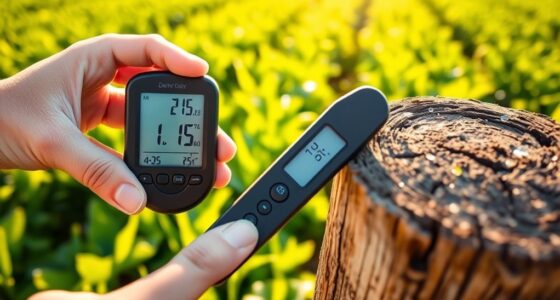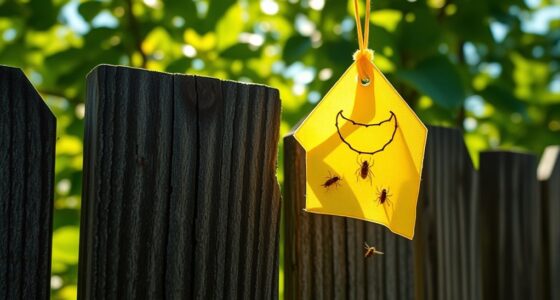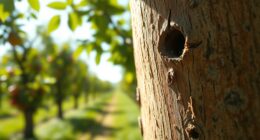To calibrate your sweep net and beat sheet, start by inspecting each tool for tears, loose threads, or damage and repair or replace damaged parts. Practice your sampling technique with consistent sweeps and dropping insects from a fixed height to test collection efficiency. Regular maintenance, such as cleaning and proper storage, keeps your equipment in prime condition. Want detailed steps to guarantee your tools give accurate results? Keep exploring for more tips.
Key Takeaways
- Inspect and repair mesh, frame, and handle for tears or looseness before calibration.
- Test sampling area with a consistent sweeping motion to standardize technique.
- Use controlled, uniform sweeps to minimize variability and ensure reproducibility.
- Drop insects of known size from a fixed height to assess and adjust the beat sheet’s collection efficiency.
- Regularly clean, store, and inspect equipment to maintain optimal condition and calibration accuracy.

Calibrating your sweep net and beat sheet is essential for collecting accurate and consistent insect samples. Proper calibration ensures that your sampling techniques yield reliable data, allowing you to compare results over time and across different locations. It also helps prevent equipment errors that could compromise your research. To achieve this, you need to focus on both the technique of sampling and the maintenance of your equipment. Regular upkeep of your tools guarantees they remain in optimal condition, making calibration more straightforward and effective.
Start by inspecting your sweep net. Check the mesh for tears or loose threads, as damaged mesh can let insects escape or skew your counts. Ensure the frame is sturdy and the handle is firmly attached. If you notice any damage, repair or replace parts before calibration. Next, test the net’s opening size by sweeping a known area, such as a marked square of fabric or a designated section of a calibration frame. This helps you understand the net’s effective sampling area, which is crucial for standardization. Consistently using the same area during sampling maintains the integrity of your data. When using the sweep net, practice a controlled motion—sweeping in a steady, consistent manner—to minimize variability. This consistency in technique improves the reliability of your samples and reduces the chance of sampling bias. Additionally, proper technique is critical for ensuring representative samples and accurate data collection.
Similarly, calibrate your beat sheet. Check for tears or loose edges and replace or repair as needed. To calibrate the beat sheet’s efficiency, you can perform a test by dropping insects of known size and quantity onto the sheet from a fixed height. Observe how well the sheet catches the insects, and note any gaps or areas where insects might escape. This helps you determine if the sheet needs reinforcement or if the way you handle it affects collection efficiency. As with the sweep net, consistency in your beat sheet technique is vital. Use the same dropping height and angle each time to ensure comparable results. Maintain your equipment by cleaning it after each use to prevent dirt and debris from affecting performance, and store it properly to avoid warping or tears.
Frequently Asked Questions
How Often Should I Calibrate My Sweep Net and Beat Sheet?
You should calibrate your sweep net and beat sheet regularly to guarantee accurate sampling, ideally before each use or at least every few weeks, depending on how often you work with them. Consistent equipment maintenance and calibration frequency help maintain their effectiveness and reliability. If you notice any damage or changes in performance, recalibrate immediately. Keeping a routine ensures your data remains precise and your equipment stays in good condition.
Can Calibration Be Done Outdoors or Only Indoors?
You can perform calibration both outdoors and indoors, depending on your needs. Outdoor calibration is ideal when you want to account for real-world conditions like wind and vegetation, ensuring your sweep net and beat sheet are accurate in field environments. Indoor calibration offers control over variables, making it easier to fine-tune your equipment. Use outdoor calibration for field work and indoor calibration when testing in a controlled setting.
What Tools Are Necessary for Accurate Calibration?
Calibrating your sweep net and beat sheet is like tuning a musical instrument for perfect sound. You need tools like a ruler or tape measure for measurement precision and calibration weights or known insect samples to test accuracy. Keep in mind, calibration frequency depends on usage intensity and conditions; regular checks ensure consistent results. With these tools, you’ll maintain reliable sampling, making your data collection accurate and dependable.
How Do Environmental Factors Affect Calibration Accuracy?
Environmental factors like temperature, humidity, and wind can considerably impact calibration accuracy. You need environmental stability to guarantee consistent results, as fluctuations can cause calibration drift. When conditions are unstable, calibration consistency decreases, making your data less reliable. To maintain accuracy, calibrate equipment in stable environments and avoid outdoor conditions with high wind or humidity. This helps you achieve more precise measurements and reliable sampling results.
Is Calibration Necessary for Different Types of Sweep Nets and Beat Sheets?
While equipment durability varies, calibration remains vital across different sweep nets and beat sheets. You might think sturdiness negates the need for frequent checks, but calibration ensures accuracy regardless of equipment type. Regular calibration compensates for wear and tear, maintaining measurement precision. So, whether your gear is new or heavily used, calibrating your sweep nets and beat sheets is essential to obtain reliable data and optimize sampling efficiency.
Conclusion
Now that you know how to calibrate your sweep net and beat sheet, you’re all set to collect accurate data. Remember, proper calibration guarantees your findings are reliable and meaningful. Isn’t it satisfying to know your efforts truly reflect the environment around you? Keep practicing, stay attentive, and enjoy the process of exploring nature’s tiny details. With these tools calibrated just right, you’re ready to uncover fascinating insights—so why not start your next field adventure today?









